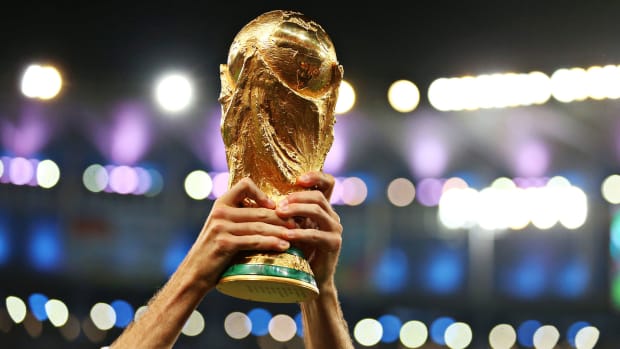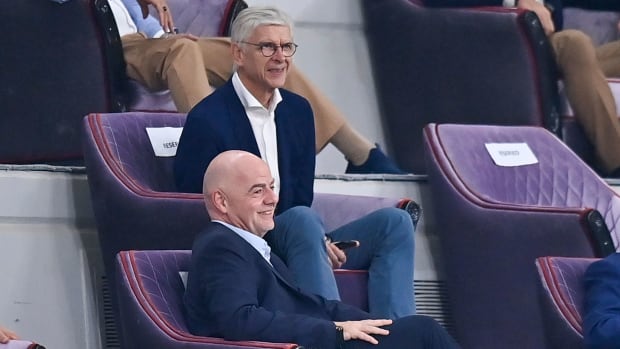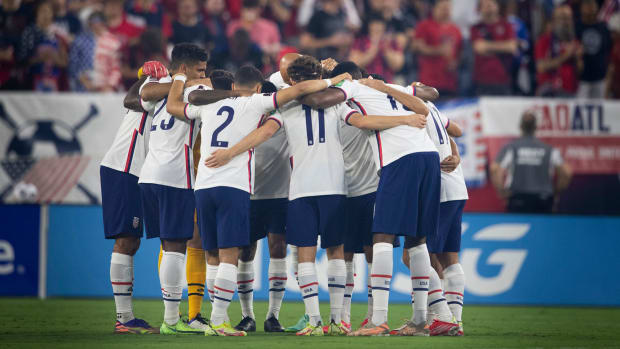FIFA's push for a World Cup every two years would change the dynamic and structure of national teams forever.
The headlines focus on the potential or peril of a World Cup every two years. That’s the power of the World Cup: It overshadows pretty much everything else. Doubling the frequency of the biggest event in sports! The continental and cultural showdown between revenue and tradition! Those controversies inevitably will be front and center of the debate.
But a biennial World Cup actually isn’t the most fundamental change FIFA is proposing. The summers are going to get filled regardless, if not by an extra World Cup, then by enlarged continental championships, Nations Leagues, club tournaments and exhibition tours, etc. Previously, FIFA president Gianni Infantino tried (and failed, apparently) to launch a biennial, 24-team Club World Cup. Like nature, soccer administrators abhor a vacuum.
Instead, the critical component of the overhaul championed by FIFA—along with many national associations, including a bunch from Concacaf—is the dramatic streamlining of the international calendar. The number of breaks for national team matches will be cut to just one (the preferred option) or two per year from around five. That reduction will fundamentally alter the very concept of a national team and therefore, the end product: the World Cup. FIFA wants to double its most precious asset. But in so doing, it risks undermining not only the value of that asset, but the quality as well.

PA Images/Sipa USA
“Often times, the commercial side of these ideas don’t include any part of how you build a team or how you develop guys or anything. There’s already been challenges to do that with national teams,” said Los Angeles FC coach Bob Bradley, who’s coached national teams and clubs on three continents. “There’s little understanding of the health of the players, the quality of the games. What you’re getting is people throwing things together without any real sense of what the quality of the games will be like.
“When FIFA gets together and all these people sit in a room and they start doing stuff," Bradley continued, "who the hell knows what they’re thinking?”
Alexi Lalas was in that room. The National Soccer Hall of Fame defender and Fox analyst was among the “FIFA Legends” invited to Doha this month for a couple of days of consultation with Infantino and “chief of global football development” Arsène Wenger, the former Arsenal manager. What they’re thinking, Lalas said, is that the world has changed and FIFA must change with it. It’s smaller. Players are no longer taking steam ships to World Cups like they did in the 1930s, and there are no more colonies or hinterlands content to stay permanently deferential to heritage or the powers that be. There’s too much competing for the commitment of potential fans. Everything happens faster, and attention spans and expectations have evolved.
“FIFA has a vested interest in the international game maintaining and hopefully increasing relevance, and with the power and leverage that many clubs and leagues around the world have, they see this as an opportunity to secure or increase the relevance of the international game, which they fear it's being diminished,” Lalas said. “They recognize that this is a seminal change, a massive change, and that it’s a jolt to the system.”
A primary concern of opponents to the FIFA plan—not to mention anyone with an understanding of rudimentary economics—is that the World Cup will lose some luster if contested twice as often. But an irony of Wenger’s vision is that he and FIFA intend to “increase the relevance of the international game” by decreasing the number of chances to play it. If their plan ultimately is approved by the FIFA Congress—Lalas said that Infantino likely has the votes—there’ll be a World Cup every two years, probably starting as soon as 2028 (the additional tournaments will share a summer with the Olympics). Summers in the odd-numbered years likely would feature men’s continental championships—watch UEFA double the frequency of the Euro in relatively short order—and a Women’s World Cup.
Wenger’s goal to is ensure that a much larger proportion of international matches matter, but that they’re staged in less time and with fewer player call-ups required (this eventually may help sway some of Europe’s more powerful clubs). That’s the compromise. And so the idea hinges on slashing the number of FIFA windows during the traditional club season. One proposal calls for a single four-to-five-week window centered around October. A second envisions two shorter breaks—one in October and a second in March-April. Friendlies would all but disappear, and all qualifying for those annual summer tournaments would take place across one or two windows.
Lalas said that the one-window plan is the preferred option. That means men’s national teams would gather twice a year—once in October and once over the summer. Clubs would go dark while their internationals were away for more than a month. National teams would go dark for the ensuing seven.

Xinhua/Sipa USA
“He loves the simplicity,” Lalas said of Wenger. “I think he looks at it that it’s clear. You’re in for that five weeks in October, and that’s it. You’re done. You go back to your club and you don’t come back until whatever you qualified for the next summer.”
If simplicity is what Wenger loves then under this new plan, simplicity is what he’ll get. Imagine it’s October 2026, and the new international calendar has been established. National teams would meet and have a few days to train and get acclimated before qualifiers for the summer 2027 tournaments kicked off (this would be Concacaf’s chance to stage its Nations League/Gold Cup qualifiers). Seven matches can be played in a month with minimal travel, so some confederations might decide to centralize their schedules, which would rob many fans of the opportunity to see their teams live. If a home-and-away format is chosen, the frequency of games likely would fall.
The reduced number of matches, minimal preparation time and possibility that an injury could force a key player to miss every qualifier (lose Christian Pulisic for three weeks, lose him for qualifying) will lead to some funky results, which FIFA will celebrate. That’s a huge part of this initiative—offering opportunities to nations that have struggled to break through. Each vote from one of those FAs counts as much as Germany’s, France’s or Brazil’s.
But the compact and crucial nature of that qualifying window also will make coaches reluctant to introduce new players, to experiment or to try and fashion teams that play more complex, chemistry-reliant soccer. There’s no time to build—no time to establish unique tactics or team culture. Reductive soccer will dominate (it’s already more prevalent at the international level as it is). Coaches will be incentivized to rely on familiar faces and partnerships.
Wenger and Infantino want critical games, but they’re not going to give managers the chance to refresh or rebuild their sides. So what we’ll see in those qualifying windows, and then again seven months later in tournament play, will be all-star teams striving to play simple, mistake-free soccer. The era of standing national teams will end. In fact, FAs won’t even need a full-time manager on the payroll. A chosen club coach can manage the national squad during the qualifying window and then again over the summer while their other team lies dormant. It’ll be similar to what USA Basketball, USA Hockey and Hockey Canada do for the Olympics. Just hire an NBA, NCAA or NHL coach part-time, then send him back to his team.
Those coaches essentially will be managing an all-star side: introduce everybody and then roll the ball out. Whoever happens to be in form and healthy at the time will have a chance to play. With a major tournament every single summer, some may even decline now and then like we see with NBA players and the Olympics. Every national team will be an ad hoc collection of athletes brought together for that specific time, tournament and place. There will be almost no chance for growth or continuity.
“It means that probably putting together a team is more about scouting and knowing your pool, and in a short amount of time making sure the guys are on the same page,” Bradley said. “Ultimately they would try to figure out, as you’re coming to an event, what’s the best group of guys to make the team."
Bradley referenced the potential similarity with international basketball.
“They were flexible. They played a couple of lead-in games,” he said of Gregg Popovich and the U.S. basketball team prior to this summer’s Olympics. “They lost to some teams we never lose to in basketball and everyone kind of lost their minds, and then in some smart and steady way, when you have a staff of guys like Pop and [assistant] Steve Kerr, they know how to engage the players in the right away about the responsibility and the challenge and the experience. So yeah, that’s what’ll happen.
“Who would take those [coaching] jobs? It would depend. If it doesn’t impact what you’re doing with your club, somebody might say ‘yes.’ If it impacts, or if you feel like it just doesn’t fit your ideas, then people will say ‘no.’ ”

George Walker IV/The Tennessean/USA TODAY Network
The painstaking work that U.S. coach Gregg Berhalter has been doing over the course of the past three years to form a team anchored by ambitious, talented and relatively inexperienced men in their early 20s would be almost impossible. So would the evolution of new European champion Italy under Roberto Mancini, for example. There’d be no time to generate any cohesion or momentum, or to develop together on and off the field. Windows will be about short-term recovery and results—survival—not long-term improvement. For some coaches, the easiest approach might be to call up most of a single club side (assuming eligibility, of course), in order to maximize chemistry. Good players, or young players, would be left behind.
“When it comes to development, if all your eggs are in one basket you better call in people you know, and often times that’s the experienced type of players,” Lalas said, describing the all-or-nothing nature of that qualifying window. “The ability to blood young players is difficult. Or you may have a situation where a player doesn’t come of age or step up until later on, and you weren’t able to call them in because they aren’t the player they were six months earlier.”
Standing national teams that have their own identity, approach, culture and style of play are one of the great things about the sport. They’re part of a legacy that reaches back more than a century. A lot of that will disappear if FIFA pulls the trigger on this plan. But that seems like a sacrifice it’s happy to make. More countries likely will get the chance to bask in the World Cup spotlight. Infantino and Wenger can argue that they’re putting players first by reducing the number of international windows and, therefore, their travel. TV networks and sponsors will pony up so they can play a part. And fans probably will get used to a biennial World Cup, just like they get comfortable with other innovations (nobody in Mexico or Costa Rica, among other places, seems to have a problem with crowning two club champions a year).
In the end, we root for laundry. If the soccer is subpar, so be it. FIFA is pledged to grow the game, not improve it.
“I think their argument would be, ‘Yes, there is less consistency and time together in an already difficult and challenging [environment]. But ultimately I think everybody accepts that when they watch their national teams at a World Cup, there’s not the consistent understanding and cohesion that they expect from the club level,” Lalas said. “I think [FIFA] would argue that it’s still a World Cup, and it’s still your nation and it’s still an important competitive game. And you will forgive the fact that it’s not cohesive for the tradeoff of getting games that matter.”
More Soccer Coverage: